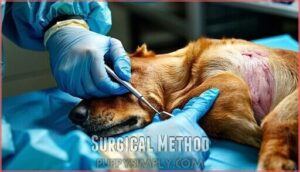This site is supported by our readers. We may earn a commission, at no cost to you, if you purchase through links.
 Neutering your dog is a smart step toward their long-term health and well-being.
Neutering your dog is a smart step toward their long-term health and well-being.
It reduces the risk of testicular cancer, curbs prostate issues, and can even help with behavior like roaming or aggression.
Plus, it prevents unwanted litters, which is a win for controlling the pet population.
While there are some risks, like potential joint problems or weight gain, these can often be managed with proper care.
Timing matters—small breeds are usually neutered earlier than large breeds, so talk to your vet about the best age.
Curious about post-op care or alternatives? There’s more to explore on this important decision.
Neutering has several benefits, including reducing the risk of certain health issues, which makes it a smart step.
It is crucial to consider the timing and potential risks, such as joint problems, to make an informed decision.
Table Of Contents
- Key Takeaways
- Neutering Benefits
- Neutering Risks
- Best Age Neuter
- Neutering Procedure
- Behavioral Changes
- Health Effects
- Alternatives Options
- Cost Considerations
- Post-Op Recovery
- Spay Neuter Difference
- Frequently Asked Questions (FAQs)
- What is the recovery time after neutering?
- Is neutering painful for the dog?
- Are there any long-term side effects of neutering?
- Is there a difference between neutering and spaying?
- Are there any age restrictions for neutering?
- How does neutering affect my dog’s energy levels?
- Will neutering change my dog’s appetite permanently?
- Can neutering impact my dog’s coat texture or thickness?
- Are there any risks of anesthesia allergies in dogs?
- How long should I wait before bathing my dog post-surgery?
- Conclusion
Key Takeaways
- Neutering reduces the risk of testicular cancer, prostate issues, and hormone-driven behaviors like roaming or aggression.
- Timing is crucial—small breeds are typically neutered earlier than large breeds to avoid joint issues and ensure proper growth.
- Post-surgery care includes activity restrictions, pain management, and monitoring the incision site for proper healing.
- Alternatives like vasectomies or chemical castration offer temporary or hormone-preserving options for those seeking non-traditional methods.
Neutering Benefits
Neutering your male dog offers several important health and behavioral advantages that can improve his quality of life.
You’ll reduce his risk of testicular cancer, prostate disease, and unwanted behaviors like roaming while preventing accidental breeding.
Reduces Testicular Cancer
Dog neutering completely eliminates testicular cancer risk, the second most common cancer in intact males.
This cancer prevention benefit is particularly essential for cryptorchid dogs with undescended testicles, who face higher tumor risks.
Early detection through castration prevents malignant tumor types from developing entirely, and by removing the source, neutering provides guaranteed protection and contributes to increased lifespan for your dog.
Decreases Prostate Disease
Neutering your dog substantially reduces prostate disease risks, including benign prostatic hyperplasia and prostatitis prevention.
Early neutering provides the best prostate health protection by eliminating testosterone that fuels these conditions.
BPH reduction occurs because enlarged prostates develop from hormonal stimulation over time, and without testicles producing hormones, disease severity decreases dramatically, keeping your dog’s prostate healthier throughout his life, which is a result of prostate health protection and hormonal stimulation.
Reduces Roaming Behavior
Intact males often wander miles searching for mates, driven by powerful hormonal urges.
Dog neutering substantially reduces this risky roaming behavior by eliminating testosterone-fueled impulses that override training and safety.
Here’s how neutering helps control wandering:
- Eliminates scent-driven searches – Unaltered females in heat won’t trigger your dog’s instinct to roam
- Reduces territory expansion – Neutered dogs maintain smaller, manageable territory sizes
- Improves training effectiveness – Less hormonal distraction means better focus on commands
Prevents Unwanted Breeding
Beyond behavioral improvements, neutering offers the most reliable offspring control for responsible ownership.
You’ll prevent accidental litters that contribute to pet overpopulation and shelter burden. Every unplanned breeding adds to the overpopulation crisis, supporting puppy mills indirectly.
Dog neutering eliminates reproductive capability completely, ensuring you won’t accidentally contribute to the millions of homeless pets.
| Breeding Prevention | Impact |
|---|---|
| Accidental litters prevented | 100% effective |
| Shelter admissions reduced | Significant decrease |
| Puppy mill demand lowered | Less commercial breeding |
| Community overpopulation controlled | Long-term population stability |
Neutering Risks
While neutering offers many benefits, you should understand the potential risks before making this decision for your dog.
Research shows neutered dogs face increased chances of joint problems, obesity, hypothyroidism, and certain cancers, especially when the procedure happens too early.
Increased Joint Issues
Research shows early neutering substantially increases your dog’s risk of developing joint issues.
Large breeds face three times higher rates of hip dysplasia and cruciate ligament tears when neutered before one year.
Growth plates haven’t fully closed yet, creating orthopedic conditions that affect musculoskeletal health, and breed predisposition compounds these risks, making timing absolutely critical for your dog’s long-term mobility.
Heavier dogs may face increased risks of joint disorder risk if neutered early.
Increased Obesity Risk
Your dog’s metabolism slows down after dog neutering, making weight gain more likely.
Metabolic changes reduce energy needs while many dogs maintain the same activity levels and food intake.
This combination creates a perfect storm for dog obesity.
Breed predisposition also plays a role – some breeds gain weight faster than others.
Owner awareness about dietary adjustments becomes critical for preventing neutering side effects like excessive weight gain, which is why understanding metabolic changes is key.
Increased Hypothyroidism Risk
Your dog’s metabolic changes after neutering create a perfect storm for hypothyroidism development.
Neutered dogs face three times higher risk than intact pets, with energy levels dropping substantially post-surgery.
Key hypothyroidism risk factors include:
- Breed predisposition in larger dogs
- Hormonal disruption affecting thyroid function
- Weight management challenges requiring careful monitoring
Regular thyroid screening helps catch early warning signs.
Some breeds, like the Doberman Pinscher have increased risk, are more prone to this condition due to their genetic makeup.
Potential Surgical Complications
While dog neutering is generally safe, surgical complications can occur.
Infection risk at the incision site affects 1-3% of cases. Bleeding issues may develop if your dog becomes too active post-surgery.
Anesthesia reactions, though rare, can cause breathing problems or allergic responses. Swelling complications around the surgical area are common but usually resolve quickly.
Hernia formation occasionally develops when tissue weakens. Your veterinarian monitors for postoperative infection signs, including infection risk, bleeding issues, and anesthesia reactions.
Best Age Neuter
You’ll find that timing your dog’s neutering correctly can substantially impact their long-term health and development.
The best age depends on your dog’s breed size, with small breeds typically ready around 6-12 months and large breeds benefiting from waiting until 18-24 months, which affects their overall development.
Large Breed Considerations
Large dog breeds face unique challenges when timing neutering decisions.
Timing matters more for Great Danes than Chihuahuas when planning neutering surgery.
Your Great Dane or German Shepherd needs different considerations than smaller dogs.
Here’s what matters most for large breeds:
- Growth Plates – Wait until 18-24 months when growth plates fully close
- Joint Health – Early neutering doubles hip dysplasia risk in large breeds
- Cancer Risks – Breed-specific studies show increased risks with early procedures
- Optimal Timing – After age 2 substantially improves long-term health outcomes
Small Breed Timing
Small breeds typically reach maturity faster than their larger counterparts, making neutering age considerations quite different.
You can safely neuter most small dogs around 9 months without significant early neutering risks to growth plate closure.
These breeds show minimal joint complications from standard timing, and their behavioral development progresses quickly, with breed-specific guidelines supporting traditional neutering schedules for ideal long-term health outcomes.
Factors Affecting Optimal Age
Several key factors determine your dog’s ideal neutering age beyond breed size.
Growth plates close at different rates, making age considerations imperative for bone development.
Your pup’s individual health status, breed predisposition to certain conditions, and social maturity timeline all influence timing.
Hormonal influence on dog growth and development varies substantially, and early neutering may impact dog age-related health outcomes differently for each pet.
Neutering Procedure
When you decide to neuter your dog, you’ll want to understand what happens during this common surgical procedure.
Your veterinarian will use general anesthesia to remove your dog’s testicles through a small incision near the scrotum, making it a straightforward operation that typically takes 20 to 30 minutes.
Surgical Method
Two primary incision types define the neutering procedure: the scrotal technique and prescrotal technique.
Your vet makes a small incision near the scrotum for testicles removal during dog castration.
Scrotal ablation may follow in some cases.
The surgical approach uses absorbable suture material for closure.
Laparoscopic options offer minimally invasive alternatives to traditional open surgery methods.
Anesthesia Used
Your dog receives general anesthesia during neutering, guaranteeing complete unconsciousness and pain-free surgery.
Veterinarians use monitoring equipment to track heart rate, breathing, and blood pressure throughout the procedure. Preanesthetic blood tests check organ function to minimize anesthetic complications.
While anesthesia risks exist, modern protocols make serious adverse events rare. Dog anesthesia monitoring helps guarantee pet safety.
Anesthesia cost is typically included in your total neutering fee.
Post-Op Care Instructions
After anesthesia wears off, your dog’s recovery depends on proper postop care.
Monitor the incision site daily for swelling or discharge.
Follow your vet’s medication schedule for pain management.
Restrict activity levels for 10-14 days – no running or jumping.
Keep that recovery cone on to prevent licking.
Pet first aid knowledge can be life-saving.
Watch for signs of infection during dog surgery recovery.
Behavioral Changes
You’ll likely notice changes in your dog’s behavior after neutering, though results vary between individual dogs.
Neutering typically reduces hormone-driven behaviors like aggression, mounting, and roaming, but won’t solve all behavioral issues since training and genetics play larger roles.
Reduced Aggression
Many dog owners hope neutering will reduce aggression, but the reality isn’t black and white.
While dog neutering can decrease some hormone-driven aggressive behaviors, it won’t fix all behavior issues.
Training and early socialization remain your best tools for managing unwanted behaviors.
- Fear aggression often stems from poor socialization, not testosterone levels
- Resource guarding requires specific training techniques regardless of neuter status
- Breed predisposition plays a larger role than hormones in aggressive tendencies
- Training impact far outweighs neutering effects on most behavior problems
- Some dogs may actually become more fearful after surgery
Decreased Mounting Behavior
Neutering can reduce mounting behaviors, though results vary between individual dogs.
This unwanted behavior often stems from dominance, excitement, or sexual drive rather than just hormones.
Dog neutering may decrease mounting on inappropriate targets like furniture or people, but training solutions remain essential.
Some breed differences affect response rates, and social context and consistent correction work better than surgery alone for complete behavior modification.
Changes in Roaming Behavior
Your male dog’s wandering days will likely decrease after neutering, though testosterone reduction varies by individual.
Breed predisposition and training influence play key roles in roaming behavior.
Environmental factors like fencing and supervision matter more than surgery alone.
Dog neutering reduces the urge to seek mates, but won’t eliminate escape-artist tendencies or aggression-driven wandering completely.
Health Effects
When you neuter your dog, you’ll see significant health improvements that can extend their lifespan.
This procedure reduces your pet’s risk of testicular cancer, prostate disease, and various infections while helping them live longer, healthier lives.
Reduced Cancer Risk
Preventing testicular cancer stands as one of dog neutering’s most significant benefits.
Your male dog’s cancer risks drop dramatically after the procedure, eliminating testicular tumors entirely.
Certain breeds show higher cancer predisposition, making early detection essential.
While neutering benefits include tumor prevention across various cancer types, survival rates improve when you address these health risks proactively through surgical intervention.
Decreased Infectious Diseases
Beyond cancer protection, dog neutering substantially strengthens your pet’s immune system and reduces infection susceptibility.
Your neutered dog faces fewer health threats because reproductive organs often harbor bacteria and create vulnerability points.
Here’s how neutering improves disease prevention:
- Eliminates testicular infections that can spread throughout the body
- Reduces prostate infections and related complications
- Decreases wound infections from fighting and territorial disputes
- Minimizes post-op infections during routine procedures
- Strengthens overall immune response by removing hormone-related stress
Increased Lifespan
Research consistently shows your dog’s lifespan increases after neutering through multiple Mortality Factors reduction.
Disease Prevention eliminates testicular cancer risks while Injury Reduction occurs from decreased roaming and fighting behaviors.
Though Genetic Predisposition and Breed Longevity vary, most neutered dogs live longer, healthier lives.
This dog health benefit makes neutering a smart choice for pet longevity.
Alternatives Options
You can choose alternatives to traditional neutering that offer different levels of hormone preservation and reversibility.
Vasectomies prevent breeding while maintaining natural hormones, and chemical castration provides temporary infertility through hormone-suppressing implants, which can be considered a form of reversibility.
Chemical Castration
Chemical sterilization offers a non-surgical path for dog owners seeking alternatives to traditional neutering.
Deslorelin implants like Suprelorin temporarily suppress testosterone production without permanent removal of reproductive organs.
Here are three key chemical castration options:
- Deslorelin Implants – Provide 6-12 months of infertility with reversible effects
- Zinc Gluconate Injections – Offer permanent sterilization through targeted chemical delivery
- GnRH Treatments – Temporarily block hormone production while maintaining behavioral benefits
Vasectomy Procedure
A vasectomy offers dog neutering alternatives by cutting the vas deferens while preserving testosterone production.
This procedure maintains your dog’s natural hormones and male reproductive system function.
Unlike traditional neutering, vasectomy reversibility remains possible, though sperm storage isn’t typically needed.
Procedure variations exist, but long-term effects show continued hormone benefits.
Ethical considerations favor preserving natural biology while preventing reproduction.
Temporary Infertility Methods
You can temporarily halt your male dog’s reproduction without permanent surgery through reversible sterilization methods.
Deslorelin implants suppress fertility for 6-12 months by blocking testosterone production. Chemical castration offers another alternative, though it requires repeated treatments.
Notably, supplements, like those marketed for fertility, are subject to federal regulation of supplements.
Future research continues developing improved fertility suppression techniques. These alternatives preserve your dog’s natural male reproductive system while preventing unwanted breeding when vasectomy isn’t preferred.
Cost Considerations
Neutering costs typically range from $50 to $500, depending on your location, veterinarian, and your dog’s size.
You can find low-cost spay and neuter programs through local animal shelters, which often offer the procedure for $50 to $150, providing a more affordable option.
Average Neutering Cost
Dog neutering cost varies substantially across the country, typically ranging from $50 to $500.
Here’s what affects your final bill:
- Geographic Variance – Urban areas cost 2-3x more than rural locations
- Breed Cost differences based on size and complexity
- Vet services level (clinic vs. specialty hospital)
- Hidden Fees for pre-surgical bloodwork and medications
- Long-Term Savings from preventing future health issues
These factors contribute to the overall cost, and understanding them can help you prepare for the procedure and its associated expenses.
Low-Cost Programs Available
You don’t have to break the bank for dog neutering.
Low-cost programs through state health departments, non-profits like SpayUSA, and local shelters offer reduced fees.
Eligibility requirements typically involve income verification through the application process.
These programs combat pet overpopulation while making neutering cost manageable.
Program locations include mobile clinics and participating veterinary offices, funded by community impact initiatives and government sources.
Factors Affecting Cost
Several factors influence your dog neutering cost beyond the base procedure.
Location matters substantially—urban veterinary care typically costs more than rural clinics.
Clinic reputation and experience level affect pricing, while anesthesia type and monitoring equipment add expenses.
Breed size impacts surgical complexity and recovery time.
Pre-surgical bloodwork, pain medications, and potential complication costs can increase your final pet surgery bill substantially.
Unexpected costs like preventative medication expenses should also be considered for budgeting.
Post-Op Recovery
Your dog’s recovery after neutering requires careful attention to activity restrictions, pain management, and proper wound care.
You’ll need to monitor your pet closely for the first few days, as most dogs experience reduced appetite and fatigue before returning to normal within 48 hours, which is a key part of post-operative care.
Activity Restriction
After covering neutering costs, your dog’s recovery depends heavily on proper activity restriction. Your furry friend needs controlled movement to protect the incision site during neutering recovery.
Follow these activity guidelines for proper dog recovery:
- Leash Walking Only – Short, supervised walks prevent jumping hazards and protect incision care
- Play Avoidance – No running, wrestling, or rough games for 10-14 days
- Stair Climbing Limits – Restrict stairs to prevent strain on the incision site
Controlled exercise guarantees proper healing. Watch for signs of post-operative lethargy, which could indicate complications.
Pain Management Options
While keeping your dog calm helps healing, effective pain medication forms the backbone of comfortable neutering recovery.
Your vet will prescribe post-op analgesics suited to your dog’s needs, combining NSAID usage with opioid alternatives when necessary.
| Medication Type | Common Examples | Duration |
|---|---|---|
| NSAIDs | Rimadyl, Torbugesic | 3-5 days |
| Local anesthetics | Lidocaine blocks | During surgery |
| Multi-modal approach | Combined therapies | As needed |
| Opioid alternatives | Gabapentin | 2-4 days |
This multi-modal approach guarantees maximum comfort during incision care and anesthesia recovery.
Many owners purchase dog post-operative NSAIDs for their pets.
Follow-Up Care Instructions
Schedule your followup visit within 10-14 days for incision monitoring and stitch removal.
Follow your vet’s medication schedule for pain medication exactly as prescribed. Keep the protective collar on until stitches are removed to prevent licking.
Many owners seek a cone alternative for dogs. Limit exercise to short leash walks only.
Clean the incision gently with warm water if directed, watching for swelling or discharge.
Spay Neuter Difference
When you hear the terms "spaying" and "neutering," you’re actually hearing about two different surgical procedures based on your dog’s gender.
Spaying removes a female dog’s ovaries and uterus, while neutering removes a male dog’s testicles.
Spaying Female Dogs
Spaying dogs involves removing your female’s ovaries and uterus through ovariohysterectomy.
This surgical procedure prevents heat cycles, eliminates pyometra risk, and substantially reduces mammary tumor development when performed before maturity.
Here are four key spaying benefits:
- Pyometra Prevention – Eliminates life-threatening uterine infections
- Heat Cycle Effects – No more messy bleeding or unwanted attention
- Laparoscopic Spaying – Minimally invasive option available
- Spaying Complications – Generally low when performed by experienced vets
Neutering Male Dogs
When you choose dog neutering for your male companion, the castration procedure removes both testicles under anesthesia protocols.
This eliminates testosterone production and male dog reproduction capabilities.
Your vet will make scrotal incisions, using appropriate suture types for closure.
Watch for recovery complications and cryptorchidism risks in dogs with undescended testicles requiring specialized care.
Key Differences Explained
While both procedures achieve sterilization, the surgical variations between male and female dog neutering differ substantially.
Male dog neutering involves removing testicles through small scrotal incisions, affecting hormone levels minimally.
Female dog neutering requires abdominal surgery with greater procedure invasiveness, causing more dramatic anatomical changes, and recovery timelines vary accordingly – males typically heal faster than females, influencing post-operative dog behavior and dog neuter risks.
Frequently Asked Questions (FAQs)
What is the recovery time after neutering?
Your dog usually recovers from neutering within 10-14 days.
Most return to normal activities after two days, but keep them calm, monitor the incision site, and follow your vet’s instructions for a smooth recovery.
Is neutering painful for the dog?
Imagine drifting into a deep sleep, unaware of the world—neutering feels painless for your dog thanks to anesthesia.
Post-surgery, mild discomfort is managed with pain meds, ensuring your furry friend recovers comfortably and safely.
Are there any long-term side effects of neutering?
Neutering can lead to long-term effects like increased obesity risk, joint issues, and certain cancers in some breeds.
Hormonal changes may also affect behavior or metabolism.
Timing and breed-specific factors substantially influence these outcomes.
Is there a difference between neutering and spaying?
Neutering removes a male dog’s testicles, while spaying removes a female dog’s uterus and ovaries.
Both surgeries prevent reproduction, but spaying is more complex.
Each is done under anesthesia, ensuring your pet feels no pain.
Are there any age restrictions for neutering?
Neutering can be done as early as eight weeks, but timing depends on your dog’s breed and size.
Smaller breeds mature faster, while larger breeds benefit from waiting until growth plates close, around 18-24 months, which is a critical period for their development.
How does neutering affect my dog’s energy levels?
Think of neutering as hitting a reset button on hormonal energy.
Your dog’s energy might shift slightly, often becoming steadier.
While they may calm down, regular exercise and mental stimulation keep them lively and healthy.
Will neutering change my dog’s appetite permanently?
Neutering can slightly lower your dog’s metabolism, which might increase their appetite over time.
However, permanent changes depend on factors like diet and exercise.
Managing portions and activity levels helps maintain a healthy weight post-surgery.
Can neutering impact my dog’s coat texture or thickness?
Studies show hormonal changes after neutering can sometimes alter your dog’s coat, especially in breeds with double coats.
You might notice a softer or thicker texture, but it doesn’t happen to every dog.
Are there any risks of anesthesia allergies in dogs?
Yes, dogs can have allergic reactions to anesthesia, but it’s rare.
Vets perform pre-anesthetic tests to minimize risks.
Always share your dog’s medical history to help guarantee a safe procedure and smooth recovery.
How long should I wait before bathing my dog post-surgery?
After surgery, give your dog’s skin a break—wait at least 10-14 days before bathing.
This guarantees the incision heals properly, avoiding irritation or infection.
Stick to gentle cleaning if absolutely necessary, like wiping with a damp cloth.
Conclusion
Deciding on neutering your dog is a big step, but it’s one that can greatly benefit their health and behavior.
From reducing cancer risks to preventing unwanted litters, the advantages are clear.
While there are potential risks like joint issues or weight gain, these can often be managed with proper care.
Timing is key, so consult your vet to determine the best age for your dog, which ultimately supports their well-being and helps control the pet population.
- https://www.avma.org/resources-tools/pet-owners/petcare/spaying-and-neutering
- https://www.thekennelclub.org.uk/health-and-dog-care/health/health-and-care/a-z-of-health-and-care-issues/neutering-a-dog-castrating-and-spaying/
- https://pmc.ncbi.nlm.nih.gov/articles/PMC6940997/
- https://www.aspca.org/pet-care/general-pet-care/spayneuter-your-pet
- https://www.dogcancer.com/articles/causes-and-prevention/are-there-reasons-not-to-neuter-your-dog/



















